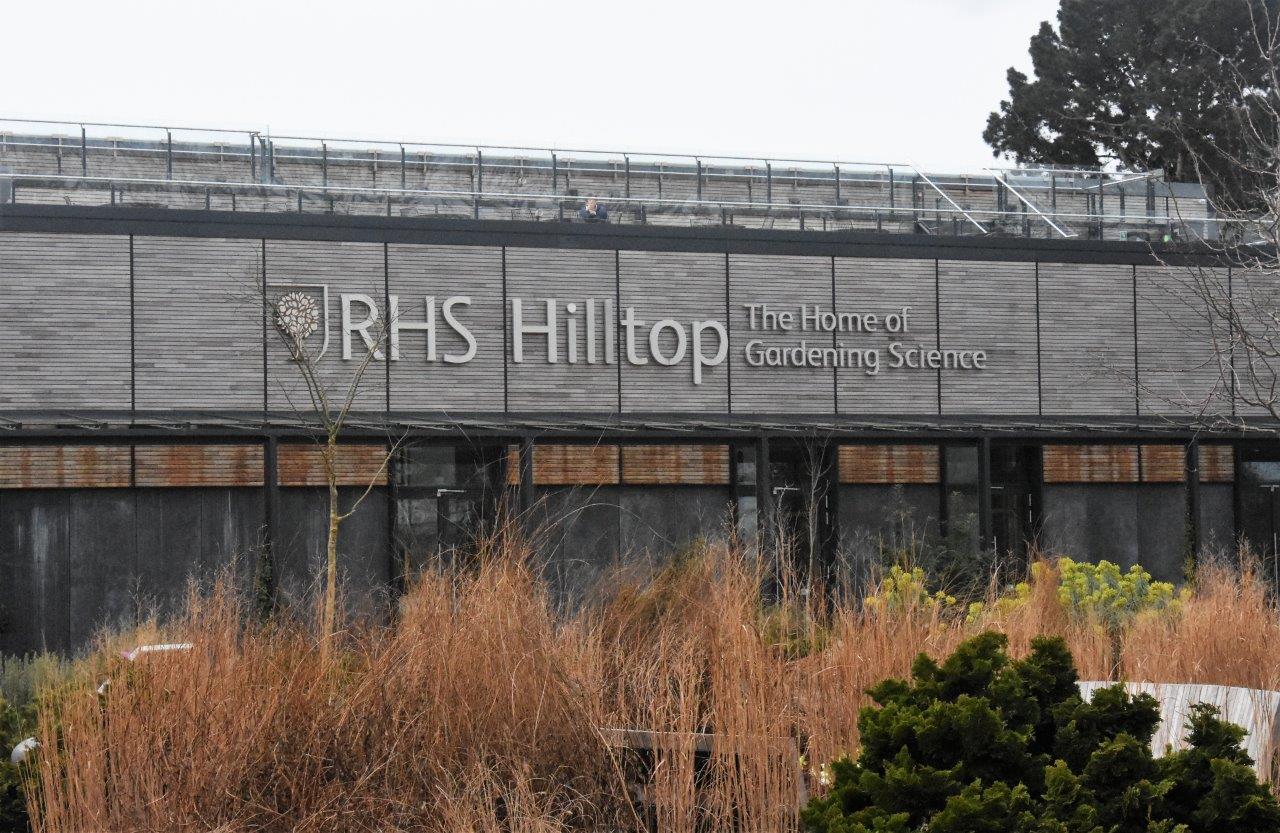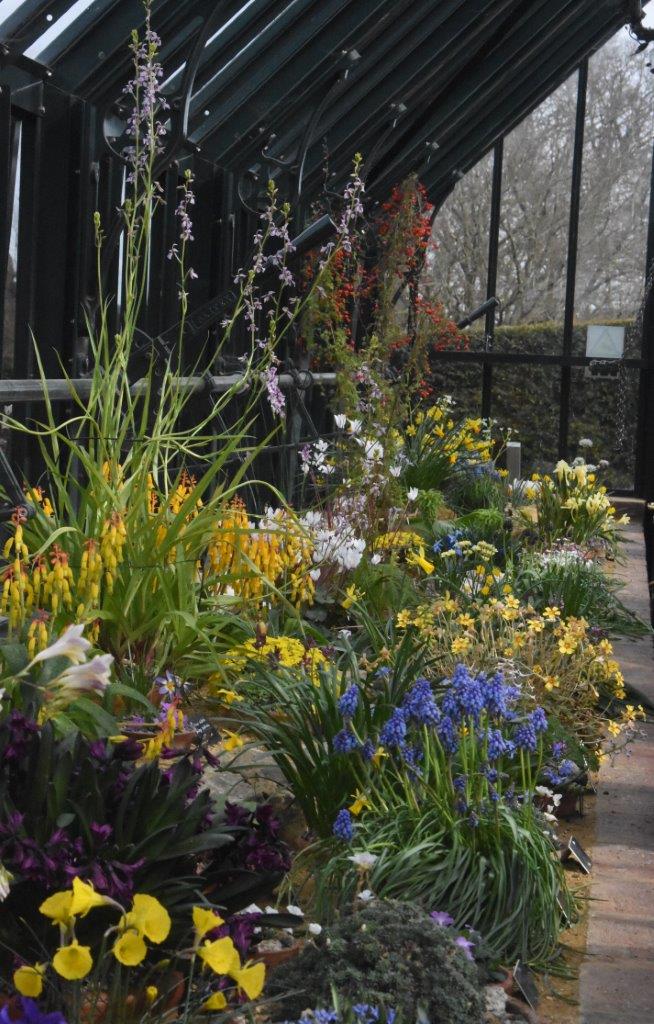Behind the scenes day at Wisley
Wednesday 15 March 2023

Coffee and pastries available on arrival made a good start to the day before we left in our assigned groups to the Alpine area and Herbarium.
The Hilltop Centre is the new home for the Herbarium in the dedicated horticultural science centre housing the offices of the scientific research staff. We met members of the Taxonomy unit and botanists working on, amongst other projects, plant genera and families for the annual RHS Plant Finder. It was interesting to learn about the digitisation of plant records currently underway, so that soon, for some species, the public can access online records from the RHS archives. Here staff also conduct research projects, a current study being into hedging species for rainfall mitigation, another a plant collecting programme adding missing cultivars, then dissecting, cataloguing, and mounting them for the extensive RHS archives. The herbarium room is kept at a steady 16 °C and stores over 90,000 specimens, plus more than 3,000 illustrations by artists dating back to the 1930s. Kindly laid out for us to see were specimens used to compile the 1840 Flora Graeca, plants of Greece, plus a copy of the book donated to the RHS by the Hanbury family of La Mortola in Italy.
With limited time, we moved on to the Rock Garden and Alpine Houses. Specimens are grown in terracotta pots plunged in sand to keep the moisture levels constant. The Alpine house looked pristine, but one shouldn’t forget the 5,000 plants maintained behind the scenes to allow a display of that standard of ‘looking good’ for the public. Of note was that all watering was done by hand; that’s a lot of watering!
After an excellent lunch and catch up with other members we took a walk through the winter garden, past some excellent hellebores, cornus, hamamelis and other gems to arrive at the Centenary Glass House and explore what is held behind the scenes there to keep the displays in tip top condition. Entry into the service areas revealed a treasure trove of tropical delights. One of the most noticeable plants was Worsleya procera, the rare blue amaryllis from Brazil, rarely seen and along with Paramongaia weberbaueri, or giant Peruvian daffodil, probably the two most sought-after exotic bulbs. Many other ‘goodies’ were there too.
Over 5,000 specimens are in the glasshouse on display, a real plant theatre, and 3,000 more to be tended to behind the scenes.
After the harsh change in weather this winter in a short period, the plant damage to more tender specimens in the garden was noticeable. Defoliation and dehydration was seen on many pittosporums, corokias, rosemary and other Mediterranean favourites, especially in areas like the walled garden and where they are managed by clipping. The plantings of similar specimens in the Battleston Hill area where they were more natural in style and frost passed over them flowing downhill seemed to have fared better and survived in many cases unscathed.
When Lesley and Melvyn were visiting the garden on the various planning trips, we were made aware that some plants in the garden were not at their best, the topiarised shrubs in the walled garden were an obvious example. We know it was that awareness that prompted curator Matthew Pottage to contact us before the planned date to enquire if we wished to postpone. We felt that it was informative to be aware that professionals and amateurs were beset with the same kind of problem, even feeling that if places like Wisley had plant casualties then it might put our own plant losses in perspective.
The common reaction to the feeling of being caught unaware by the weather was due to the changes being quite sudden and quite extreme. Very dry heat late summer, followed by heavy rain and then very low temperature frosty weather for several days and nights.
RHS Wisley is the home of one of the meteorological weather stations often referred to in media weather reporting. Data from here is collected by Dr John David, RHS Head of Horticultural Taxonomy. He was able to give us precise detail of weather variation experience in the previous nine months. The following gives a clear picture of what the plants had to cope with.
During the drought, through all of July and August they had 3mm of rain in 46 days. The drought began to break on 16 August but then there was 33.5mm of rain on 25 August. In the previous period from April to July only 41 per cent of the usual amount of rain was received. Total rainfall in September was 93.6mm of which 59mm fell in four days from 5 to 8 September and then 44.6mm fell on 23 October (which is the average amount of rain for a summer month). The highest temperature recorded was 38.6 °C on 19 July, a new record for Wisley. They recorded 41 days over 25 °C of which nine were over 30 °C. The standard for a warm summer day is taken as 25 °C.
The lowest temperature recorded was –8.1 °C on 15 and 16 December: the winter was the coldest recorded since 2010. The December cold wave recorded 12 days with frost on every night and one ice day (daily max temperature below 0 °C) The January cold wave lasted for ten days, the lowest temperature recorded was –7.7 °C and they had two ice days. Ice days at Wisley are relatively rare and most years they get through winters without having a single one.
In all it was a very enjoyable day. Huge thanks are due to Lesley Jones and Melvyn Jope for their excellent organisation and guidance.
Text: Sue Tymon and Melvyn Jope
Photos: Lesley Jones and Melvyn Jope














